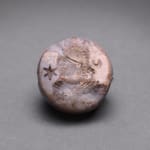Sassanid Agate Seal with a Royal Portrait, 200 CE - 600 CE
Agate
2.2 x 2.2 x 1.6 cm
7/8 x 7/8 x 5/8 in
7/8 x 7/8 x 5/8 in
FJ.4237
Further images
In 244 A.D., Ardeshir I founded the Sassanid Dynasty, the last native Persian Kingdom to rule Ancient Iran before the Islamic conquest. The Sassanid era was a golden age of...
In 244 A.D., Ardeshir I founded the Sassanid Dynasty, the last native Persian Kingdom to rule Ancient Iran before the Islamic conquest. The Sassanid era was a golden age of Persian culture that witnessed the revival of Zoroastrianism, an ancient mystical religion native to these lands, and a literary Renaissance spurred by the translation of many Old Persian epics recorded in cuneiform into the Middle Persian language of Pahlavi written in an alphabet derived from Aramaic. By introducing heightened international trade and commerce they created a legacy of political and economic diplomacy. They sponsored trade with the Romans (later on the Byzantines), their archenemy, to the west and the Chinese to the east. Excavations in China have unearthed gold and silver Sassanid coins covering a span of many centuries until the demise of the Empire during the reign of Khosrow II. However, the fall of the Empire had already started with a series of wars waged under the rule of Khosrow I, the father of Khosrow II. Challenged by the intensification of the same international commerce that had bore such wealth, struggles for national power and international prestige had escalated to an ungovernable degree. In the face of threats to his royal house, Khosrow II embarked upon military campaigns that would prove unsuccessful. By the close of his reign, the once mighty Sassanid Empire came to an end, paving the way for the rise of Islam in the Middle East.
Since the dawn of time, mankind has used signets and seals to symbolize power, authority, and magic. In many ancient cultures, a seal impression signified the will of its owner, his signature, his deed of possession. This rare seal dates from the height of the Sassanid empire, which rivaled Rome in size and splendor. It depicts a king or prince wearing ornate robes and a helmet. Very likely this is the portrait of one of the great Sassanid warrior kings. It may have been used by a general or governor to carry out the royal wishes, or it may have been a token of honor for some noble. Though the empire that created it has vanished, the seal's air of majestic authority remains undimmed by time.
Since the dawn of time, mankind has used signets and seals to symbolize power, authority, and magic. In many ancient cultures, a seal impression signified the will of its owner, his signature, his deed of possession. This rare seal dates from the height of the Sassanid empire, which rivaled Rome in size and splendor. It depicts a king or prince wearing ornate robes and a helmet. Very likely this is the portrait of one of the great Sassanid warrior kings. It may have been used by a general or governor to carry out the royal wishes, or it may have been a token of honor for some noble. Though the empire that created it has vanished, the seal's air of majestic authority remains undimmed by time.





